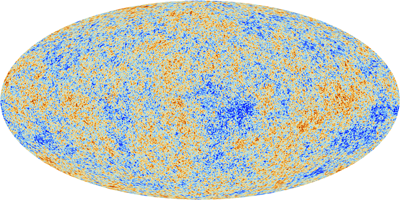
Plus Advent Calendar Door #14: The cosmic afterglow

A map of temperature variations of the cosmic microwave background formed from data taken by the Planck spacecraft. Red represents regions that are hotter than average and blue represents regions that coder than average. This cosmic background radiation can be seen all over the sky. In this map the whole sky has been projected onto a two-dimensional oval. Click here for a larger image. Image: ESA and the Planck Collaboration.
At night the space between the stars and planets is black to the naked eye. Were you to look at it with a highly sensitive radio telescope, however, you'd see it permeated by a faint and ever-present glow. That glow is the cosmic microwave background (CMB). When Arno Penzias and Robert Wilson detected it in 1964, they thought the effect was down to droppings from pigeons that were nesting in their telescope's antenna. They carefully cleaned the equipment, caught the pigeons and released them some distance away. But the glow remained, and it gradually became clear that Penzias and Wilson had made one of the most important scientific discoveries of the twentieth century.
The pigeons paid the ultimate price. When they kept returning the scientists shot them. "It's not something I'm happy about, Penzias is quoted as saying, "but that seemed like the only way out of our dilemma."
What is the CMB?
"The cosmic microwave background radiation is the earliest light we can see in the history of the Universe", explains Hiranya Peiris, Professor of Astrophysics at University College London. "It's the left-over heat from the Big Bang and [provides] a baby picture of the Universe." The reason we can't see this ancient light with the naked eye is that it lies outside of the visible spectrum. It's mostly within the microwave region of the spectrum, hence its name.
This animation illustrates how the Planck Satellite made a picture of the CMB. The resulting spherical image is then projected onto the oval picture shown above. The red band running across the CMB in this image comes from light from the Milky Way, which gets in the way of the CMB. However, it is possible to remove this band to get the image above. Copyright: ESA.
Indeed, the CMB is the reason we know (or are as certain as we can be) there was a Big Bang at all. At the time of the CMB's discovery another theory for the history of the Universe was competing with the hot Big Bang theory. Rather than envisioning our Universe as having exploded into being from an incredibly hot and dense beginning, the steady state theory saw the Universe as having existed forever. But the steady state theory does not predict the sort of glow in the Universe seen in the CMB. A hot Big Bang Universe, on the other hand, would naturally include radiation left over from its dramatic beginning — Big Bang theory predicts that the CMB should exist. Thus, the discovery of the CMB gained the Big Bang theory near-universal acceptance and Penzias and Wilson one half of the 1978 Nobel Prize in Physics.
The messengers
The CMB radiation originated around 380,000 years after the Universe was born. That may not sound very young, but 380,000 is just a tiny fraction of the Universe's current age of 13.8 billion years. In human terms, the CMB is comparable to a picture of a baby less than one day old.

Hiranya Peiris, Professor of Astrophysics at University College, London.
It's also the oldest light we can possibly see. For roughly the first 380,000 years the Universe was opaque to light. Free electrons that were not bound to nuclei of atoms were moving through space. Electromagnetic radiation — light — consists of particles called photons, and these were scattered by the electrons as they bumped into them. "It's a bit like sunlight on a cloudy day," says Peiris. "You can't see past the clouds because the light gets scattered."
As the Universe expanded, however, it also cooled down, a process that favoured the formation of neutral atoms. Electrons were now bound to the nuclei of these atoms. They were no longer free and the photons were no longer scattered. "Since then the photons have been propagating to us without interacting with anything, until they got eaten by our detectors," says Peiris. "It's a long, lonely journey carrying messages from the very early Universe." And while we can't see the CMB radiation directly, we don't need to own high-tech equipment to detect it. An old TV is enough: about 1% of the static on an old and untuned TV screen comes from CMB radiation.
To really decipher the CMB messages, however, you do need more sensitive measuring equipment than an old TV. To find out more, and to find out more about what the CMB can tell us about the Universe and its history, read the full version of this article.
This year's advent calendar was inspired by our work on the documentary series, Universe Unravelled, which explores the work done by researchers at the Stephen Hawking Centre for Theoretical Cosmology and is available on discovery+. Return to the 2020 Plus Advent Calendar.
Comments
Nancy Brown
This was truly the very thing I was looking for. Great article. Learn us